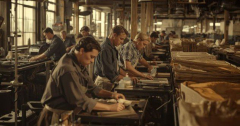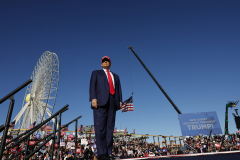In an age of global supply chains, the phrase “Made in the U.S.A.” might seem like a fading echo of the past. Yet, the story of American manufacturing is one of evolution, not extinction. In the early 1900s, at the height of its industrial revolution, the United States accounted for about a quarter of all global manufacturing output, dominating the production of cars, planes, and industrial machinery.
By 2025, that figure has dropped to roughly 17% as other nations have industrialized and become competitive players on the world stage. But while America’s global share may have diminished, the ingenuity behind “Made in the U.S.A.” survives. Recent bipartisan initiatives in the United States, such as the CHIPS Act, have tried to give a boost to manufacturing in the United States. In this list, we’ll shine a light on ten projects that are either currently being manufactured in the United States or will be soon. Let’s rev up our engines and take a drive through 10 signs that Made in the U.S.A. still lives.
Related: Ten Billion Dollar Blunders: When Companies Set Cash on Fire
10 Jazz Mouthpieces Born in Savannah’s Soul
How the Best Saxophone Mouthpieces are Made
Jody Espina’s story is uniquely American—and unusually rare. He began his career as a professional musician and dedicated music professor whose first love was jazz, a form of music born in the United States. His career path took a pivotal turn in 1999 when he met the legendary saxophonist and mouthpiece maker Santy Runyon, who, in a remarkable coincidence, had taught Espina’s own boyhood music teacher. Espina worked with Runyon to develop a custom mouthpiece and loved the result so much that he immediately saw the potential for mass-producing the design. The idea of JodyJazz mouthpieces was born.
Runyon, who was already 93 years old at the time, recognized Espina’s passion and accepted him as a student. For three years, he mentored Espina, teaching him the intricate art and business of making saxophone mouthpieces. Espina became so committed to the craft that he made the life-changing decision to leave his teaching career and dedicate himself full-time to his new venture. This period of intense, old-world apprenticeship laid the foundational principles of quality and craftsmanship that would define the JodyJazz brand.
The company’s manufacturing takes place at its factory in Savannah, Georgia, using a process that combines machine work with manual finishing. Each mouthpiece is initially carved on a 5-axis CNC machine to achieve consistency in the core design. After the initial milling, technicians perform detailed hand-finishing on critical areas like the tip rails, baffle, and chamber. As a final quality control step, every mouthpiece is play-tested by Espina or a member of his team to ensure performance.[1]
9 The World’s Best-Selling Helicopters Still Built in California
Kurt Robinson, President and CEO of RHC, takes Vertical Magazine on a tour of the Robinson factory.
While much of the U.S. manufacturing of high-technology equipment like helicopters has moved overseas, Robinson Helicopter is a notable exception. The company was founded in 1973 by engineer Frank Robinson, who had a simple but unprecedented idea: build a reliable, affordable helicopter for the masses. After failing to convince his employers at large aerospace firms, he struck out on his own to create a personal aircraft that wasn’t made solely for the military or the ultra-wealthy. He pursued his goal with relentless focus on simplicity and efficiency.
Robinson established a “Made in the U.S.A.” philosophy based on vertical integration within the company’s factory in Torrance, California. From its beginning to today, the company has produced the vast majority of its own parts in-house. The entire process, from welding the chromoly steel frames and machining components from raw stock to forming the composite rotor blades, is done under one roof. This gives Robinson control over quality, cost, and the supply chain of every aircraft it builds.
The company’s models—including the two-seat R22, the four-seat R44, and the turbine-powered R66—have become among the best-selling civilian helicopters in the world. Since its humble beginnings, Robinson has delivered more than 13,000 helicopters to over 90 countries. While every one of them starts life in Torrance, they serve a global market, perfectly embodying the slogan: “Made in America, Engineered for the World.”[2]
8 Taylor Guitars Reinvents the American Strum
The Ultimate Taylor Guitars USA Factory Experience! | Full Factory Tour!
For much of the 20th century, the United States was a dominant manufacturer of guitars, but during the 1970s, a crisis of rising costs, declining quality control from established brands, and intense competition from Japanese manufacturers emerged. To survive in this environment, Taylor Guitars, founded in 1974, pioneered a new philosophy. Instead of traditional, labor-intensive methods, they strategically integrated technology with craftsmanship to solve the core problems of inconsistency and inefficiency that plagued their American competitors.
The key to Taylor’s survival was rethinking how a guitar was built. Their El Cajon factory utilized CNC (Computer Numerical Control) machines and lasers to achieve a level of precision unattainable by hand, which was integral to their most important innovation: the patented, bolt-on Taylor Neck. This design solved the difficult and expensive problem of neck resets, guaranteed consistent playability straight from the factory, and was more efficient to produce.
This combination of automation for precision and skilled craftspeople for assembly allowed Taylor to produce high-quality instruments at scale. Their efficiency and quality secured their position in the high-end market, while a second facility in Tecate, Mexico, allowed them to compete in more accessible price ranges. This dual-nation strategy, built on a foundation of U.S.-based innovation, helped Taylor grow into a leading global brand.[3]
7 Virginia Chips Keep the Digital World Alive
How Micron’s Building Biggest U.S. Chip Fab, Despite China Ban
While much of America’s chip manufacturing moved overseas, Micron Technology survived and thrived by pursuing a different strategy: it became the only U.S.-based manufacturer of DRAM memory chips, and a major U.S. producer of NAND flash. Instead of competing directly on cutting-edge logic processors, Micron focused on foundational components of all digital devices: DRAM (active memory) and NAND (storage). This specialization created a stable business that was indispensable to the tech ecosystem, allowing the company to invest in its U.S. fabs even as others left.
Micron’s facility in Manassas, Virginia, exemplifies this by producing long-lifecycle DRAM chips, the ultra-reliable memory required by the automotive, industrial, and defense sectors. Rather than chasing the fastest, newest chip, this plant produces vital components that remain in service for years. This focus on critical, long-haul electronics made Micron an essential partner for industries where supply chain security is paramount, cementing its role in domestic manufacturing long before it became a political priority.
When the U.S. government passed the CHIPS and Science Act to revitalize domestic production, Micron was not starting from scratch; it was already a cornerstone of American semiconductor manufacturing. The expansion of the Manassas fab is a doubling down on a proven strategy.[4]
6 Oklahoma Jeans That Outlast Generations
Executive Q&A with Round House owner Jim Antosh (2016-01-20)
In 1871, a customer in Reno, Nevada, asked a tailor named Jacob Davis for pants that could wit





